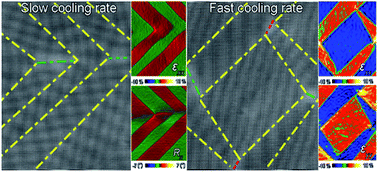Modulation of charged a1/a2 domains and piezoresponses of tensile strained PbTiO3 films by the cooling rate
Abstract
Controlling domain width, orientation, and patterns in oxide ferroelectrics are not only important for fundamental research but also for potential electronic application. Here, a series of PbTiO3 thin films under various cooling rates were deposited on (110)-oriented NdScO3 substrates by pulsed laser deposition and investigated by using conventional transmission electron microscopy, Cs-corrected scanning TEM and piezoresponse force microscopy. Contrast analysis and electron diffraction revealed that PbTiO3 films are a1/a2 domain patterns under large tensile strains with different cooling rates. The a1/a2 domains distribute periodically and the domain width increases with decrease in the cooling rates. Upon increasing the cooling rate, the domain density increases and the domain configurations become complicated. There are special square frame-like domain patterns with charged domain walls found in the PTO films with the fast cooling rate. PFM measurement shows that the PTO films with high cooling rate exhibit enhanced piezoresponse behavior which is ascribed to the high density domain/domain walls and special domain configurations. The formation mechanism of the different domain configurations is discussed in terms of the effect of cooling rates, defects and thermal kinetics. These results are expected to provide useful information for domain/domain wall control and thus facilitate further modulation of the properties for potential applications.

- This article is part of the themed collection: Editors' Collection: Ferroelectric and Multiferroic Materials


 Please wait while we load your content...
Please wait while we load your content...